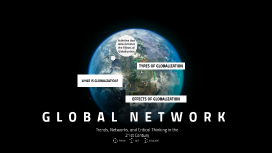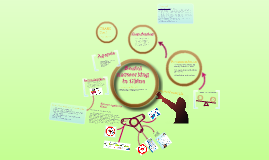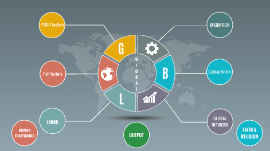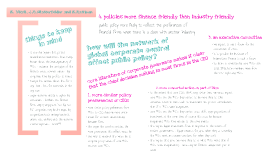Global network
Transcript: Prepared by Group 3 S3230578 LIN YUPING S3269825 SUN QIAN S3295297 WANG YUE S3262264 HE XIAOPENG S3263868 FU MOXIN Agenda Introduction Current applied in China Practical example Recommendation Conclusion Introduction Development of technology brings the internet popularization growing. The statistics of the internet users in the world by regions in 2011 shows that Asian is the most apart of the internet user in those areas. The benefits in development of social media. Cuts down the distances Rises up people getting more knowledge and information around the world Communication Sharing, gathering information and advertising Online purchase and book Current applied in China Definition of the Social Media -A comprehensive concept that includes SNS (Social Networking Service), Blog, Mini-blog, BBS, IM, Email, and a series of Internet-based information and communication (technology), and by the numerous nodes (people) base on their expertise, preferences and values spread after filter process (Scribd 2011) types compare & contrast characteristics Types & History Compare & contrast Characteristics China's Social Media is dominated by local players. More than 60% Chinese having access to Social Media sites with their mobile phone. Micro blogging more popular in China than in the United State. 50 million users 30% of China’s internet population Currently applied in China Practical example China VS. Worldwide Application develop Platform develop Recommendation 1.Creating new demand and meeting customers’ need 2.co-opearation with online game fires 3.Regulation information Conclusion Social networking is important Chinese social networkings is developing as its own way Both benefits and barriers exist Chinese networks should more focus on Platform development References Bennett, 2011, Media Censorship in China, viewed 16th September, 2011,ProQuest database. http://www.cfr.org/china/media-censorship-china/p11515 CNNIC, 2011, 'The 27th Statistical Survey Report about Internet Development in China by CNNIC', Jan 2011, viewed 20th September, 2011. Crampton Thomas, 2011, ‘social media in China: the same, but different’, The China business review, vol 38.1, Jan-Mar 2011, pp28-31, viewed 10th September, 2011, ProQuest database. <http://search.proquest.com.ezproxy.lib.rmit.edu.au/docview/847393405/fulltext/131F57A65007255281/1?accountid=13552> Internet World Stats 2009, Internet Users in the World Distribution by World Regions-2009, Miniwatts Marketing Group, viewed 12nd September, 2011. < http://www.internetworldstats.com/stats.htm> Internet World Stats 2010, Internet Users in the World Distribution by World Regions-2011, Miniwatts Marketing Group, viewed 12nd September, 2011. < http://www.internetworldstats.com/stats.htm> Internet World Stats 2011, Internet Users in the World Distribution by World Regions-2011, Miniwatts Marketing Group, viewed 14th September, 2011, < http://www.internetworldstats.com/stats.htm> Kelikuru, 2011, ‘China SNS brands Tencent QQ, Baidu, Kaixin001, Renren surface’, viewed 13rd September, 2011, www.kelikuru.com/china-online-sns-tencent-qq-baidu-kaixin001-renren-surface Scribd, 2011, ‘social network analysis: high-impact strategies’, viewed 16th September, 2011, ProQuest database. <http://www.scribd.com/doc/61340181/Social-Network-Analysis-High-impact-Strategies-What-You-Need-to-Know-Definitions-Adoptions-Impact-Benefits-Maturity-Vendors > 360i 2011, 4 Lessons about Social Media in China from Hong Kong, 360i, viewed 16 September 2011, <http://blog.360i.com/events-conferences/social-media-china > Qualman, 2011, China Social Media: 6 Critical Sites, viewed 16th September, 2011, http://www.socialnomics.net/2011/02/16/china-social-media-6-critical-sites/ THANK You ! Any question? Social networking in China (cc) photo by medhead on Flickr

















